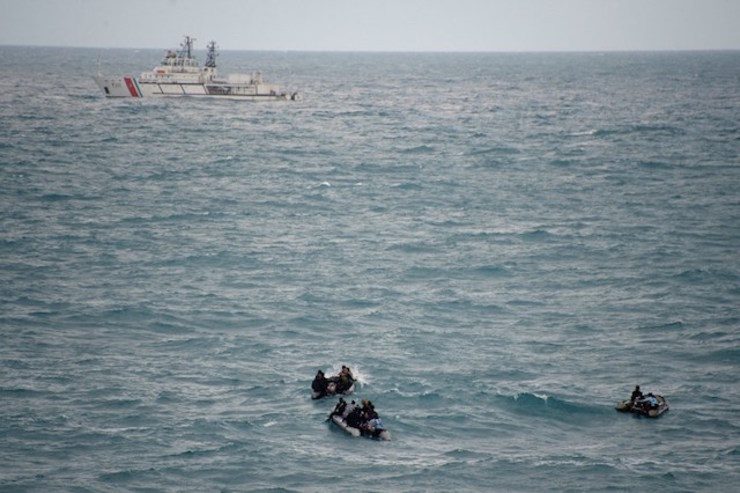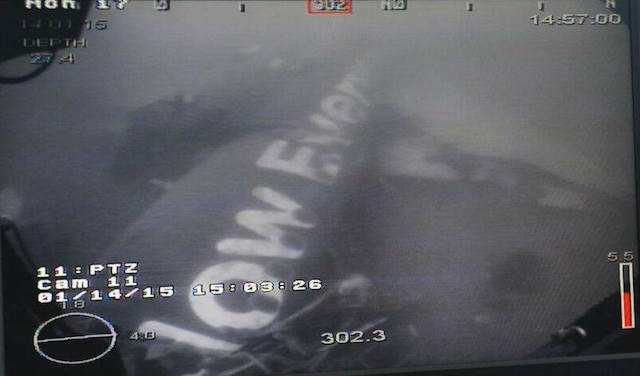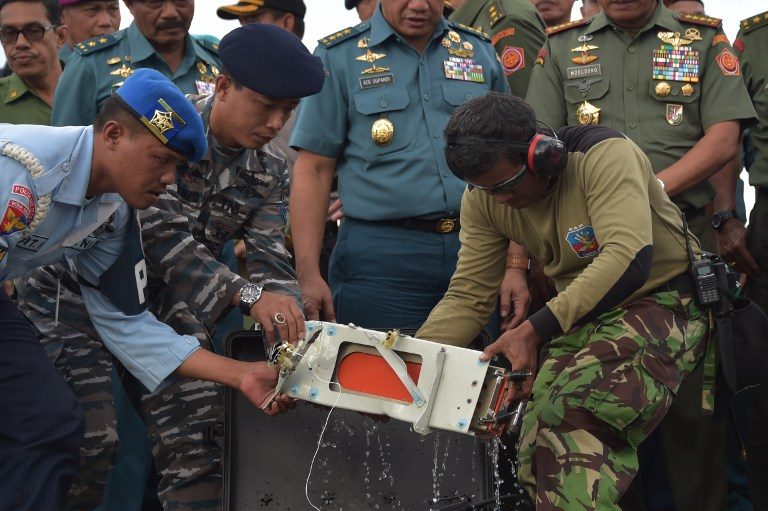SUMMARY
This is AI generated summarization, which may have errors. For context, always refer to the full article.

PANGKALAN BUN, Indonesia – Indonesian divers Thursday failed to reach the drowned main body of an AirAsia jet that crashed last month, as bad weather and rough seas hampered efforts to reach the remaining victims’ bodies.
Flight QZ8501 went down on December 28 in stormy weather during what was supposed to be a short trip from the Indonesian city of Surabaya to Singapore, with 162 people on board.
After a lengthy search, a Singapore military vessel spotted the fuselage – the main trunk of the plane – at the bottom of the Java Sea on Wednesday.
Indonesian divers Thursday failed to reach the drowned main body of an AirAsia jet that crashed last month, as bad weather and rough seas hampered efforts to reach the remaining victims’ bodies.
Flight QZ8501 went down on December 28 in stormy weather during what was supposed to be a short trip from the Indonesian city of Surabaya to Singapore, with 162 people on board.
After a lengthy search, a Singapore military vessel spotted the fuselage – the main trunk of the plane – at the bottom of the Java Sea on Wednesday. (READ: Main body of crashed AirAsia jet located)
So far just 50 bodies have been recovered, but authorities hope the main section will contain most of the bodies of passengers and crew.
Underwater photos taken by high-tech search equipment showed the fuselage and part of Malaysia-based AirAsia’s motto – “Now Everyone Can Fly” – painted on the plane’s exterior.

Divers tried to reach the wreckage in the morning and again in the afternoon, but did not succeeded in getting close enough to the fuselage, which is about 30 meters (100 feet) under water, to make an initial assessment. (READ: Divers hunt for victims in crashed AirAsia jet’s main body)
“Our diving operation was hampered by bad weather,” search and rescue agency official S.B Supriyadi told AFP.
“It was raining heavily, there were high waves, the visibility under water was less than 2 meter and there were strong currents.”
Divers will go down again early on Friday, he added.
Officials say if divers have problems retrieving bodies from the aircraft while it is still on the seabed, rescuers will try to lift it. (READ: How divers battle nature in hunt for AirAsia debris)
The fuselage is attached to part of a wing, and the wreckage is 26 meters long.
Rescuers have already used giant balloons to lift the plane’s tail out of the water after it was found about 2 kilometers (1.2 miles) from the main body.
‘I have new hope’
Farmer Aris Siswanto, whose wife’s body has yet to be recovered, said he was relieved the fuselage had finally been found.
“I have waited anxiously for 19 days now without any certainty,” the 42-year-old, who lives close to Surabaya, told AFP.
“With the discovery of the fuselage I feel like I have new hope, even if it is only the hope of seeing my wife’s remains.”
MV Swift Rescue, the Singaporean ship that located the main body of the wreck, was part of a huge international hunt that also included boats from the US and China.
Officials said the search was now being scaled back, with most international vessels leaving.
Earlier this week search teams discovered the jet’s black boxes – the flight data recorder and cockpit voice recorder – which should contain crucial information to help determine why the plane went down.

The boxes have been flown to Jakarta, where Indonesia’s National Transportation Safety Committee is leading a probe into the accident helped by experts from countries including France and the US.
Indonesia’s meteorological agency has said bad weather may have caused the crash, but only the black boxes will be able to provide definitive answers.
The flight data recorder holds a wealth of information about every major part of the plane, including details such as its speed and the direction it was travelling. The voice recorder stores radio transmissions and sounds in the cockpit.
Safety committee head Tatang Kurniadi said 174 hours of data had been downloaded from the flight data recorder, and 2 hours and 4 minutes from the cockpit voice recorder.
The data must now be converted into a usable format before the lengthy analysis process can begin.
Shortly before disappearing, the pilot had asked for permission to fly at a higher altitude to avoid a major storm, but the request was not approved due to other planes above him on the popular route.
In his last communication, the experienced pilot said he wanted to change course to avoid the storm before. Then all contact was lost, about 40 minutes after take-off.
All but 7 of those on board the flight were Indonesian. – Rappler.com
Add a comment
How does this make you feel?





There are no comments yet. Add your comment to start the conversation.